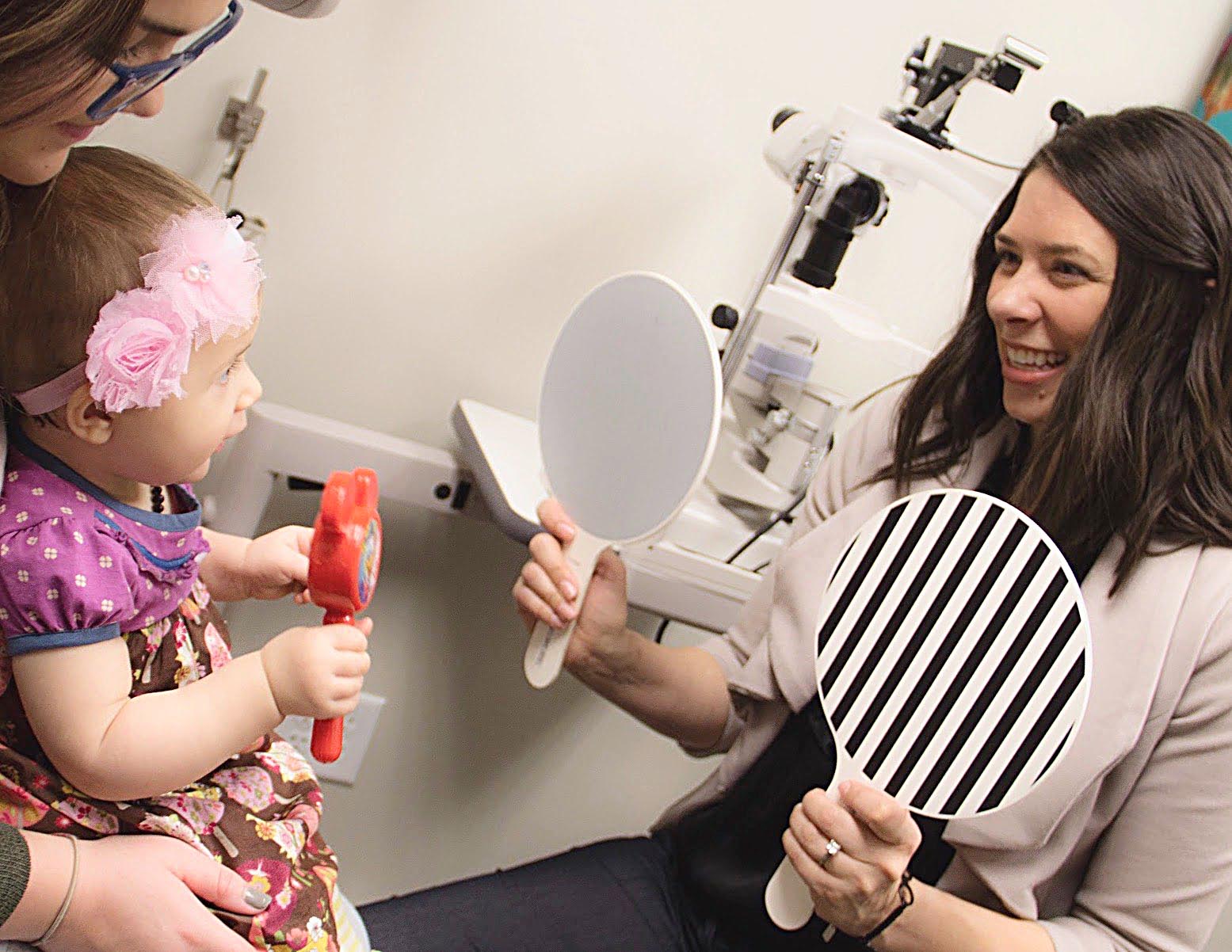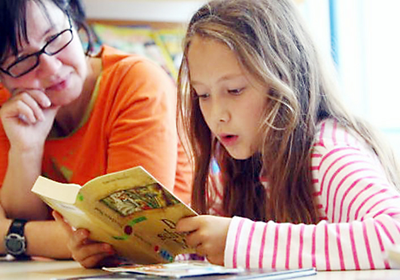
No-Cost Exams for Infants and Toddlers
Many parents don’t realize infants are born with very limited vision. Vision is actually learned during the first few months of life. Vision happens in the brain, and a baby’s brain has to learn to use its eyes just like it has to learn to use its muscles and limbs to crawl and walk. When they’re born, infants don’t have full color vision, and they can only focus just a few inches from their face. They start to learn to focus by looking at faces and later at colorful toys brought near them, gradually expanding the distances at which they can see clearly. Likewise, infants have little control over their eye movement and have to move their whole head to move their eyes, but by 8-12 weeks they’ve started to develop tracking skills and can start to follow moving objects with just their eyes. Newborns also haven’t learned to use their eyes together yet, so sometimes their eyes will go different directions or cross, which can be very alarming to new parents! But by four or five months babies learn to coordinate their eye movements and establish good eye teaming skills. Eye hand coordination usually starts to develop around this time as well, and by four months they’re starting to see in full color! If vision has developed normally, babies are ready to see and enjoy their colorful new world!
But what if vision hasn’t developed normally? Uncorrected vision problems can impair a child’s overall development. The longer a vision problem goes undiagnosed and left untreated, the more a child’s brain learns to compensate and poor visual skills become more ingrained and harder to correct. Early detection and treatment provide the best opportunity to correct vision problems so your child can learn to see normally. This is why a comprehensive eye examination is so important for young children.
The American Optometric Association recommends children have their first eye exam at six month of age. Dr. Barton fully agrees! In fact, she participates in both the AOA’s InfantSee and the Eye Care Council’s See to Learn programs. As a part of these programs, Dr. Barton offers free comprehensive exams for infants between 6 -12 months and toddlers 3 years of age in order to ensure they have a good visual start in life! Please call our office at 722-4900 for more information about scheduling your child for a no-cost appointment.
Vision and Learning
When most parents think about vision, they think about their children’s eyesight, i.e., visual acuity as measured by the eye chart. When children have 20/20 vision, it means they can see what an average person sees on the eye chart at a distance of 20 feet. If children fail the eye chart test, they can get glasses to compensate for their eyes’ physical irregularities that cause blurry vision. But good vision is so much more than just clear eyesight at distance.
Near visual skills at close ranges are especially important to school-aged children, who spend their days viewing images at a distance of 20 inches, not 20 feet. Looking up close is much more demanding on our visual system than looking far away and involves very precise visual skills in the way we take in, or process, visual information.
At close distances, children need to the ability to coordinate or “team” their eyes in order to maintain single vision. They need to be able to track a line of print without losing their place. They need the ability to quickly adjust focus when looking from near to far, as when they’re copying from the board. Children also need to be able to interpret and make sense of what they see, commonly referred to as visual perception. Glasses cannot correct these types of problems because, unlike eyesight, visual processing problems are not caused by physical irregularities but rather by “hard-wiring” deficits in the brain caused by poor visual development in the first few years of life.
Visual processing skills develop much the same way our motor skills are acquired, i.e., with practice and use. Just as infants must learn to roll over, crawl, and walk, their eyes must also learn to track, team, focus, and interpret what they see. We’re born with all the eye structures we need for vision, but we spend the first 4-6 months of life getting hard wired in the brain’s visual cortex to use our visual equipment correctly, and then we continue fine-tuning these skills throughout early childhood.
So what happens if something goes wrong, and these important visual skills don’t develop normally? Vision becomes less efficient and takes more effort. Uncomfortable vision is especially noticeable at school where reading becomes an exercise in frustration and fatigue. Depending on the clinical criteria researchers adopt to identify the prevalence of vision deficits, studies show around 20-25% of the population have some degree of poor visual processing skills. If we isolate poor readers, this number rises significantly because nowhere is vision more demanding than at close ranges with small print. Each year as the reading demands increase and print gets smaller, children with poor visual processing skills find it harder to maintain clear, comfortable, single vision. Grades start to drop, comprehension falls, and eyestrain makes it difficult to remain on task, forcing these children to take frequent breaks. They are so often off task that they may look like they have ADD/ADHD, or their grades are so poor that teachers start questioning if they have a learning disability. Unfortunately, few teachers or parents even suspect that the underlying cause may be vision.
All school-aged children should have a comprehensive eye exam to evaluate their visual processing skills. This is a specialized area of pediatric vision care about which Dr. Barton is passionate and has completed extensive post-graduate training, including studying with one of the country’s leading experts in vision-based learning problems. When Dr. Barton sees your children for their eye exams, she will not only evaluate their sharpness of vision and general eye health, but she will also evaluate the visual processing skills required for good school performance and sustained attention.


Symptoms of Vision Problems in Children
Did you know that about 80 percent of what children learn in school is through their vision? That means if your child has an uncorrected vision problem, it could severely affect his or her development. Learn some warning signs you should look for that may indicate you child has a vision problem
- Sitting close to the TV. While it is not true that sitting too close to the TV will ruin your eyes, this habit could be a sign of a vision problem. If your child cannot see the screen clearly or read from books without leaning in close, it could mean he or she is nearsighted.
- Holding a book too closely. If your child holds a book too close when reading, this could be a sign of a focusing or eye teaming problem.
- Rubbing eyes frequently. Children often rub their eyes when they’re tired or upset, but if your child rubs his eyes while he’s trying to concentrate on something, while he is being active, or while reading or using the computer, it could mean that he has a vision problem.
- Losing place while reading or using a finger when reading. When kids learn to read and are sounding out words, they’ll often use their finger to track which word they’re on. But eventually they should be able to stop using their finger and not lose their place. If your child continues to use a finger to read, ask him/her to try reading aloud without pointing. If this is hard, your child may have a tracking problem called an oculomotor dysfunction, meaning an inability to accurately control eye movements at close ranges.
- Sensitivity to light and/or excessive tearing. Are your child’s eyes particularly sensitive to indoor lighting, sunshine or camera flashes? Children with photophobia, or extreme sensitivity to light, can develop headaches and nausea. And light sensitivity can be a symptom of several eye conditions.
- Closing or covering one eye to read or turning the head to block vision from one eye. Frequently closing one eye could indicate a binocular vision problem, meaning an inability of the two eyes to work together comfortably as a team. Eye teaming problems can result in intermittent double vision or visual suppression where the brain is forced to block input from one eye. Closing one eye to read or work on the computer could be a sign of a specific eye teaming problem called convergence insufficiency.
- Receiving lower grades than usual. If your child is having a hard time seeing what his teacher writes on the board because of poor vision, he may not tell you about it. As a result, his grades can suffer. If your child seems to be struggling in school, take him for a complete eye exam — glasses or contacts could be the answer! Poor school performance can also be a sign of an eye teaming, tracking, or focusing problem.
- Avoiding using a computer, because it “hurts my eyes.” Digital eye strain is common among children who are frequent users of computers or other digital devices. Have your child take a break every 20 minutes to look at something that is at least 20 feet away for 20 seconds while she is using a digital device. If the eye discomfort persists, make an appointment for an eye exam.
- Squinting or tilting the head to see the class board better. Teachers should be on the lookout for students who have to squint or tilt their heads to see the board. Until an eye exam can be performed, consider moving the child closer to the board for easier viewing.
- Headaches while reading or working on the computer. Frequent headaches when reading or working on the computer can be a sign of a focusing or eye teaming problem.
If you notice any of these symptoms in your child, please schedule an appointment. School can be difficult enough without compounding the problem with an undiagnosed vision problem!


